On paper, the Buccaneers added a lot of big names in the offseason. Tom Brady and Rob Gronkowski from the Patriots, a former top-5 pick at running back in Leonard Fournette, and an All-Pro wide receiver in Antonio Brown. Tampa Bay also hit home runs with its first two draft picks, offensive tackle Tristan Wirfs and cornerback Antoine Winfield Jr..
But the Buccaneers did not have a particularly large amount of turnover compared to recent Super Bowl champions. In fact, by one measure, each of the five previous Super Bowl champions had bigger turnover than Tampa Bay. Other than Brady, most of the big names didn’t have a big impact for Tampa Bay, at least until the Super Bowl. Leonard Fournette had just 367 rushing yards during the regular season; Brown had just 483 receiving yards in 8 games; Gronk averaged 39 yards per game, the lowest mark in his career other than during his rookie season (in ’19, O.J. Howard averaged 33 yards per game for Tampa Bay). Of course, in Super Bowl LV it was a different story: our lasting image of the 2020 Bucs will be Gronkowski scoring 2 touchdowns, Brown catching a touchdown, and Fournette picking up 135 total yards and a touchdown.
How do we compare one team to its squad from the prior year? Great question! It’s tricky: we want to compare not just roster turnover, but the value of those players. The Chiefs added both Brady and LeSean McCoy, but that should not count as equal moves. Similarly, you have to look at how the player was used in the prior season. For example, Kurt Warner was on both the ’98 Rams and the ’99 Rams, but it would be poor analysis to say that the ’99 Rams had the same quarterback as they did the prior year.
Really we want to look at two things: how much was the player a part of the Super Bowl team (to avoid overemphasizing the McCoys of the world) and for players on the team, how much was that player a part of the team the prior year (to avoid the Warner problem). To measure how valuable a player was, I am going to use PFR’s AV, which does as good a job as any other metric to compare the value of players across positions and eras. For each player on each Super Bowl team, I will measure how much AV they produced as a percentage of the team’s total AV. I will also do that the year before, and then take the lower of those two values.
Let’s use a few examples. The 2020 Buccaneers had 243 points of AV, and Brady had 15 of them; therefore, he was responsible for about 6% of the team’s value. He was not on the team in 2019, of course, so Brady gets a 0 when we calculate how much of the 2019 Bucs were on the 2020 Bucs. That’s a big deal, because there is only 94% of the AV left to allocate. McCoy had just 1 point of AV, or 0.4% of the team’s AV; he also gets a zero since he wasn’t on Tampa Bay in 2019, but that has a much smaller impact. Donovan Smith had about 4% of the AV on the 2019 Bucs and 4% of the AV on the 2020 Bucs; therefore, taking the minimum doesn’t change things; he gets assigned 4%.
If we do this for every player on the 2020 roster, and take the minimum value between the percentage of AV they had for the ’20 Bucs and the percentage of AV they had for the ’19 Bucs, and then sum the results, we get a value of 60%. This may not mean a ton to you in the abstract — it wouldn’t be quite right to say that 40% of the roster turned over — but it is very helpful if we are comparing teams. [continue reading…]








